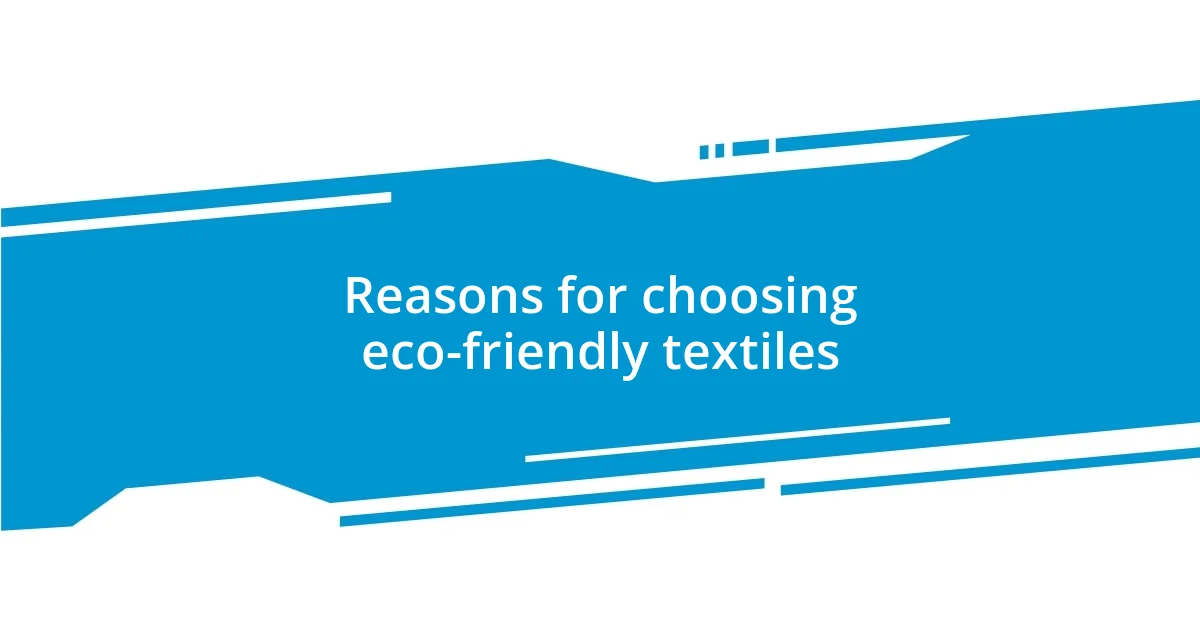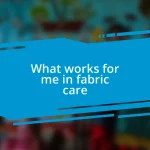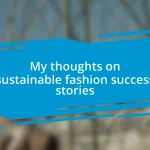Key takeaways:
- Transitioning to eco-conscious fabrics enhances personal empowerment and reflects a commitment to sustainability through mindful clothing choices.
- Researching and understanding fabric origins, certifications, and environmental impacts is crucial in making informed decisions about sustainable textiles.
- Building a sustainable wardrobe involves selecting versatile, high-quality pieces that resonate with values, encouraging meaningful connections and conversations around fashion.

Understanding eco-conscious fabrics
Understanding eco-conscious fabrics goes beyond just the material; it’s about the impact these textiles have on our planet. I remember the moment I first held a piece of organic cotton—its softness was a revelation, and it made me realize how much I had overlooked the significance of what I wore. Isn’t it fascinating how the choices we make in fabrics can contribute to sustainable practices and a healthier Earth?
When I stumbled upon hemp as a fabric option, I was genuinely surprised. Often thought of merely as a source for ropes or building materials, this versatile plant is an excellent eco-conscious alternative. It’s not only biodegradable but also requires less water and pesticides than conventional cotton. Why hadn’t I considered this before? Each time I choose such materials, I feel a sense of empowerment, knowing that I’m making a positive change with every garment I wear.
It’s intriguing to learn that many eco-conscious fabrics can be created from recycled materials, like plastic bottles or discarded textiles. Just picture the life of a bottle that was once tossed aside, now transformed into a stylish t-shirt! That journey mirrors our potential to repurpose waste and inspire creativity. Doesn’t it make you feel a sense of responsibility towards these fabrics, knowing they help reduce landfill waste while also offering unique stories?

Reasons for choosing eco-friendly textiles
Choosing eco-friendly textiles has become a pivotal decision for me, shaped by my desire to align my wardrobe with my values. I’ve noticed that sustainable fabrics not only feel good against my skin but also provide peace of mind; knowing that they’re made with fewer chemicals makes a tangible difference in my daily life. It’s an empowering experience to wear something that reflects my commitment to a healthier planet.
Here are some compelling reasons to consider eco-friendly textiles:
- Reduced Environmental Impact: Many sustainable fabrics are produced using processes that release fewer pollutants and use less water.
- Biodegradability: Materials like organic cotton and linen break down naturally, helping to minimize landfill contributions.
- Support for Sustainable Practices: Opting for eco-textiles encourages brands to adopt more environmentally responsible methods.
- Unique Quality: Eco-friendly fabrics often showcase superior craftsmanship, resulting in garments that last longer than their conventional counterparts.
- Health Benefits: Organic textiles are typically free from harmful chemicals, reducing the risk of skin irritation and allergies.
I remember the first time I wore a shirt made from recycled polyester. It felt good to know that I had chosen a fabric that diverted plastic from oceans and landfills, and it also sparked conversations. Each of these choices reinforces my belief in conscious consumerism, transforming not only my closet but my entire perspective on fashion.

Researching sustainable fabric options
Researching sustainable fabrics was an enlightening journey for me. I started by looking into different materials and their origins. Each fabric tells a story. I recall stumbling upon Tencel (or Lyocell) during my research. It’s made from sustainably sourced wood pulp, and I was impressed by its closed-loop production process, which reuses water and solvents. The thrill of finding such a versatile fabric that feels like silk yet thrives on eco-friendly principles was exhilarating.
As I dived deeper, I made a comparison table to visualize my findings on various sustainable materials. This table became a handy reference, guiding my choices and helping me better understand the environmental and ethical implications associated with each option. For me, transparency in the fabric’s journey is essential. When I realize that my clothing choices impact not just my wardrobe but also the planet, it transforms how I shop and wear fabrics.
In my quest for eco-conscious offerings, I also discovered the significance of certifications. Fabrics with labels like GOTS (Global Organic Textile Standard) or OEKO-TEX inspire trust. I felt reassured every time I selected items bearing these certifications, reflecting my commitment to sustainability. It’s like having a badge of honor, assuring me that I was contributing positively—and that emotional connection is something I never take lightly.
| Fabric Type | Key Features |
|---|---|
| Organic Cotton | Biodegradable, fewer chemicals used |
| Hemp | Requires less water, biodegradable |
| Tencel | Closed-loop production, sustainable wood sources |
| Recycled Polyester | Repurposes plastic waste, supports circular economy |

Making the initial fabric switch
Making the initial fabric switch was an eye-opening experience for me. I vividly remember standing in my closet, overwhelmed by the sheer number of options, and asking myself, “What truly aligns with my values?” It was a moment of clarity; I decided that if I couldn’t trace a fabric’s journey back to its source, I didn’t want it in my wardrobe. That simple rule became my guiding principle.
As I began to replace conventional fabrics, I made a point to donate any old items that weren’t aligned with my new path. The act of parting with clothes felt bittersweet but liberating at the same time. I even recall a conversation with a friend who shared her experiences with eco-conscious choices, which gave me a boost of confidence. It was comforting to know that I wasn’t alone in this journey; so many of us are navigating the same challenges of ethical consumption.
The first time I wore a dress made from organic cotton, I felt an incredible sense of pride. It isn’t just about the fabric’s softness or the flattering fit; it’s about what it stands for. I often find myself contemplating how every choice I make ripples out beyond my closet. When I wear sustainable materials, I feel like I’m not just making a fashion statement, but also a stand for the planet. What fabric will you choose to represent your values?

How to source eco-conscious materials
Finding the right eco-conscious materials often starts with a bit of detective work. I remember spending countless evenings scouring online forums and fabric stores, leaning on conversations with local artisans and designers. It felt rewarding to immerse myself in their stories, which helped me make choices that resonate with my values. How many times do we actually seek out this kind of connection with what we wear?
I also learned to be cautious about brand names. At first, I was swayed by catchy slogans or stylish ads, but then I realized I needed to dig deeper. I started reaching out to brands directly, asking about their sourcing practices and material transparency. More often than not, I found that the brands willing to share their practices produced fabrics that aligned with sustainability goals. From firsthand experience, authenticity in a brand’s story speaks volumes.
Another step that greatly benefited my sourcing journey was visiting local fabric markets. There, I not only uncovered unique sustainable options but also built relationships with vendors who genuinely care about the environment. I even recall the joy of discovering a small batch of recycled denim; it was like finding hidden treasure! Engaging directly with the people behind the materials transformed my shopping into something more meaningful and interconnected. Have you ever had a similar experience that made your choices feel even more significant?

Tips for eco-friendly sewing
When it comes to eco-friendly sewing, planning your projects around zero-waste patterns can make a huge difference. I remember my excitement the first time I discovered a designer specializing in patterns that maximized fabric usage. I felt a rush of inspiration when sewing a dress that didn’t leave any scraps; it made me feel responsible and creative at the same time. Have you ever considered how even the smallest changes in pattern design can contribute to reducing waste?
Additionally, invest in quality tools and materials that stand the test of time. I made the switch from disposable to reusable pins and scissors, and it completely changed my sewing experience. Not only did my workspace feel more organized, but I also felt a deeper connection to my craft. How often do we think about the longevity of the tools we use? Choosing to invest in higher-quality items often means less waste overall—a win-win situation!
Lastly, think about incorporating upcycling into your sewing practice. I still treasure the first upcycled garment I created from an old sheet. It was a simple project, but turning something I no longer used into a cozy top brought me immense joy. Upcycling allows you to narrate a new story with each piece, transforming what would have been discarded into something beautiful. Have you taken the plunge into upcycling? It’s a powerful way to breathe new life into fabric while honoring our planet.

Building a sustainable wardrobe
Building a sustainable wardrobe isn’t just about choosing eco-friendly fabrics; it’s a journey of self-discovery and a commitment to better choices. I can vividly remember the first time I cleared out my closet, surveying all those fast fashion pieces that no longer sparked joy in my life. It was liberating, but it also made me reflect: how many of these items had stories, or even lives, that mattered? This awakening made me consciously seek items that would last and resonate with my values.
Choosing versatile pieces became a guiding principle for my wardrobe. I still smile thinking about the timeless cardigan I found at a thrift store—it fits into countless outfits and carries the spirit of sustainability in every stitch. Have you ever thought about how one beloved item can effortlessly elevate multiple looks? When I made a habit of selecting quality, multi-functional pieces, my wardrobe transformed into a cohesive collection that felt intentional and meaningful.
Finally, I realized the power of storytelling in fashion. Each time I wear an eco-conscious piece, it serves as a conversation starter, sparking curiosity about its origins. I remember the excitement in a friend’s eyes when I shared the journey of a gorgeous organic cotton shirt I bought during a local artisan fair. Isn’t it fascinating how every garment can weave its own tale, connecting us to broader ideas of sustainability? This sense of community motivates me to nurture a wardrobe that goes beyond trends—it’s about embracing items that inspire connection and responsibility.
















